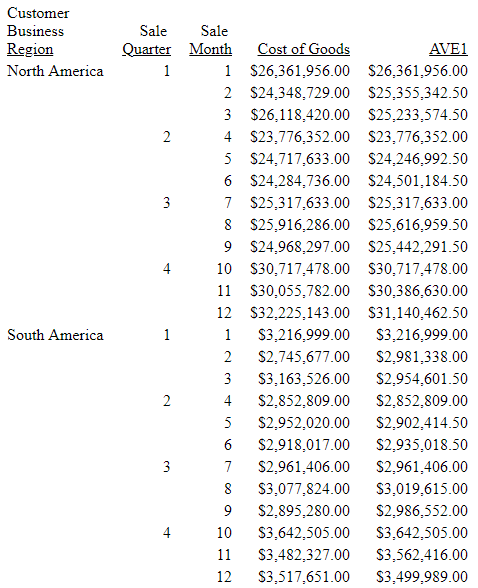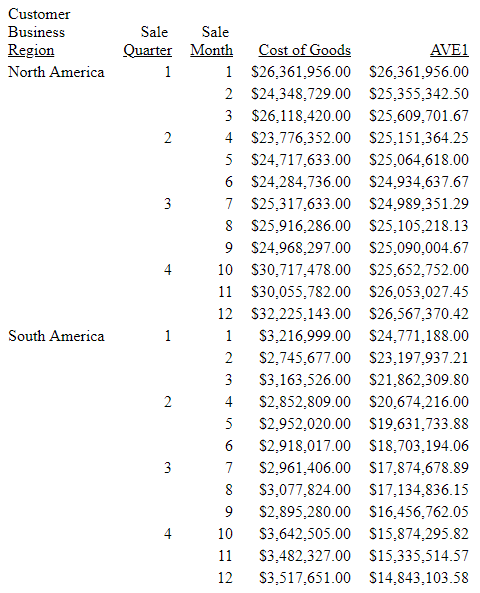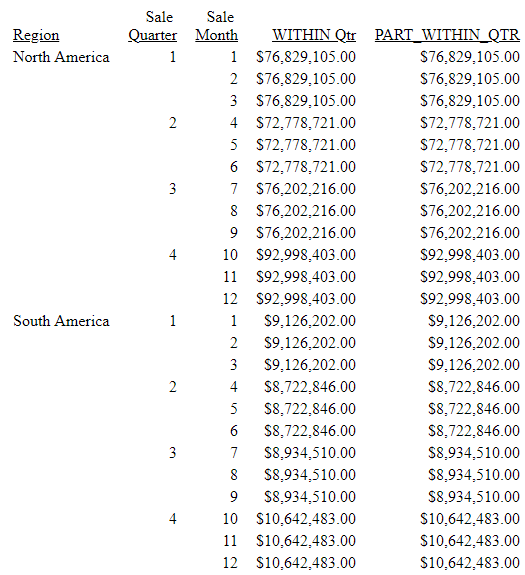Syntax: How to Generate Rolling Calculations Using PARTITION_AGGR
PARTITION_AGGR([prefix.]measure,reset_key,lower,upper,operation)
where:
- prefix.
-
Defines an aggregation operator to apply to the measure before using it in the rolling calculation. Valid operators are:
- SUM. which calculates the sum of the measure field values. SUM is the default operator.
- CNT. which calculates a count of the measure field values.
- AVE. which calculates the average of the measure field values.
- MIN. which calculates the minimum of the measure field values.
- MAX. which calculates the maximum of the measure field values.
- FST. which retrieves the first value of the measure field.
- LST. which retrieves the last value of the measure field.
- STDP. which calculates the population standard deviation.
- STDS. which calculates the sample standard deviation.
Note: The operators PCT., RPCT., TOT., MDN., and DST. are not supported. COMPUTEs that reference those unsupported operators are also not supported.
- measure
-
Is the measure field to be aggregated. It can be a real field in the request or a calculated value generated with the COMPUTE command, as long as the COMPUTE does not reference an unsupported prefix operator.
- reset_key
-
Identifies the point at which the calculation restarts. Valid values are:
- The name of a sort field in the request.
- PRESET, which uses the value of the PARTITION_ON parameter, as described in Specify the Partition Size for Simplified Statistical Functions.
- TABLE, which indicates that there is no break on a sort field.
The sort field may use BY HIGHEST to indicate a HIGH-TO-LOW sort. ACROSS COLUMNS AND is supported. BY ROWS OVER and FOR are not supported.
- lower
-
Identifies the starting point for the rolling calculation. Valid values are:
- n, -n, which starts the calculation n rows forward or back from the current row.
- B, which starts the calculation at the beginning of the current sort break (the first line with the same sort field value as the current line).
- upper
-
Identifies the ending point of the rolling calculation. The lower row value must precede upper row value.
Valid values are:
- C, which ends the rolling calculation at the current row in the internal matrix.
- n, -n, which ends the calculation n rows forward or back from the current row.
- E, which ends the rolling calculation at the end of the sort break (the last line with the same sort value as the current row.)
Note: The values used in the calculations depend on the sort sequence (ascending or descending) specified in the request. Be aware that displaying a date or time dimension in descending order may produce different results than those you may expect.
- operation
-
Specifies the rolling calculation used on the values in the internal matrix. Supported operations are:
- SUM, which calculates a rolling sum.
- AVE, which calculates a rolling average.
- CNT, which counts the rows in the partition.
- MEDIAN.
- MIN, which returns the minimum value in the partition.
- MAX, which returns the maximum value in the partition.
- MEDIAN, which returns the median value in the partition.
- MODE, which returns the mode value in the partition.
- FST, which returns the first value in the partition.
- LST, which returns the last value in the partition.
- STDP, which returns the population standard deviation in the partition. Requires using the verb PRINT to avoid duplicate aggregation.
- STDS, which returns the sample standard deviation in the partition. Requires using the verb PRINT to avoid duplicate aggregation.
The calculation is performed prior to any WHERE TOTAL tests, but after any WHERE_GROUPED tests.
Example: Calculating a Rolling Average
The following request calculates a rolling average of the current line and the previous line in the internal matrix, within the quarter.
TABLE FILE WF_RETAIL_LITE
SUM COGS_US
COMPUTE AVE1/D12.2M = PARTITION_AGGR(COGS_US, TIME_QTR, -1, C, AVE);
BY BUSINESS_REGION
BY TIME_QTR
BY TIME_MTH
WHERE BUSINESS_REGION EQ 'North America' OR 'South America'
ON TABLE SET PAGE NOLEAD
ON TABLE SET STYLE *
GRID=OFF,$
ENDSTYLE
ENDThe output is shown in the following image. Within each quarter, the first average is just the value from Q1, as going back 1 would cross a boundary. The second average is calculated using the first two rows within that quarter, and the third average is calculated using rows 2 and 3 within the quarter.

The following changes the rolling average to start from the beginning of the sort break.
COMPUTE AVE1/D12.2M = PARTITION_AGGR(COGS_US, TIME_QTR ,B, C, AVE);
The output is shown in the following image. Within each quarter, the first average is just the value from Q1, as going back would cross a boundary. The second average is calculated using the first two rows within that quarter, and the third average is calculated using rows 1 through 3 within the quarter.

The following command uses the partition boundary TABLE.
COMPUTE AVE1/D12.2M = PARTITION_AGGR(COGS_US, TABLE, B, C, AVE);
The output is shown in the following image. The rolling average keeps adding the next row to the average with no sort field break.


